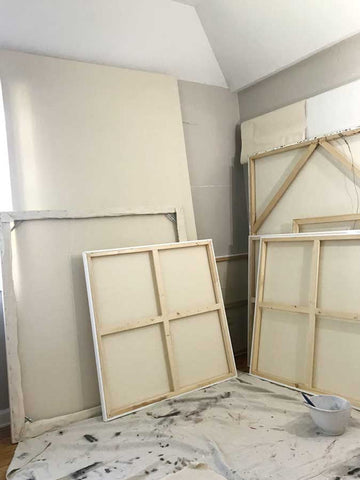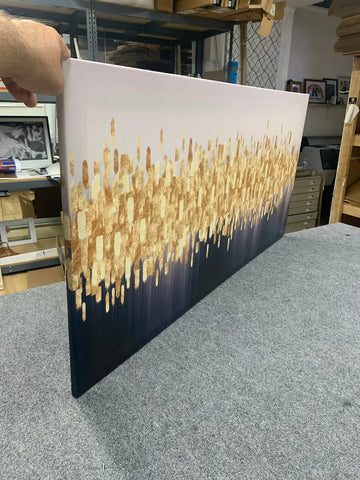Canvas stretching is the process of attaching a canvas to a wooden frame, creating a taut and smooth surface ideal for displaying artwork. Whether you're an artist looking to display your latest masterpiece, or someone who has purchased a piece of art that needs proper framing, our experienced team at Modern Memory Design is here to help.

Mail-In Service For customers who prefer to use our mail-in service, we have streamlined the process to make it as simple as possible. Simply follow these steps:
- Visit our website at Modernmemorydesign.com and navigate to the 'Canvas Stretching Service' section.
- Select the size and options for your canvas stretching service.
- Complete the online form, providing your contact information and any special instructions.
- Package your canvas securely and mail it to our store address: Modern Memory Design, 213 Boulevard, Hasbrouck Heights, NJ.
- We will notify you once we receive your canvas and keep you updated throughout the process. Once your canvas has been expertly stretched and framed, we will ship it back to you with care.
In-Store Drop Off If you're local to the Hasbrouck Heights area or prefer to visit our store in person, you can drop off your canvas directly at our frame shop. Our knowledgeable staff will be happy to guide you through the process, discuss your options, and answer any questions you may

Why Choose Modern Memory Design? At Modern Memory Design, we pride ourselves on offering exceptional quality and personalized service to our customers. Our experienced framers use the highest quality materials and expert techniques to ensure your canvas is stretched and framed to perfection. With our commitment to customer satisfaction, you can trust that your art will be handled with the utmost care and attention.
Next time you're in need of canvas stretching services, look no further than Modern Memory Design. We invite you to experience the convenience of our mail-in service, or drop off your canvas at our store in Hasbrouck Heights, New Jersey. We look forward to serving you and helping you preserve and display your cherished memories for years to
At Modern Memory Design Picture Frame Shop in Hasbrouck Heights, we are experts in providing the ideal foundation for your artwork. Whatever your preferred medium, we offer a range of stretched canvases to suit your creative endeavors, from studies and sketches to full-blown masterpieces.
Popular blank stretched canvas sizes, including:
- 8" x 10" Stretched Canvas
- 11" x 14" Stretched Canvas
- 16" x 20" Stretched Canvas
- 18" x 24" Stretched Canvas
- 24" x 36" Stretched Canvas
- 30" x 40" Stretched Canvas
- Extra Large Stretched Canvas
We can create and size blank stretched canvases for your artwork, saving you valuable time and order a stretched canvas with use custom size. Unstretched canvas typically comes in rolls, requiring you to stretch it over canvas stretcher bars or panels.

Types of Canvas
When selecting the perfect canvas, consider the choice between cotton or linen materials. Cotton canvas is generally more affordable, while linen canvas boasts a tighter weave for a more durable surface.
Our stretched canvases can come pre-primed with acrylic gesso or oil-based primer, preparing the surface for paint application. Use acrylic gesso with acrylic paint and oil-based primer with oil paint to prevent paint from soaking into the canvas weave.
Stretched linen canvas, crafted from woven linen cloth stretched around a wooden frame and secured at the back or sides with staples, tacks, or a metal spline, is made from the inner bark of a flax plant. The long fibers produce a strong, flexible, and slightly stretchy material that has been known to last centuries. Due to the extraction, processing, and weaving methods, linen canvas is typically more expensive than cotton canvas. Our stretched linen canvases are available primed with oil ground or acrylic gesso, ensuring the perfect base for your artistic creations.
As a picture framer at ModernMemoryDesign.com, I am happy to provide expert answers to your questions about canvas art and its various aspects. Here are detailed responses to your queries:
-
What is canvas made of? Canvas is typically made of tightly woven cotton or linen fabric. Cotton canvas is more common due to its affordability and versatility, while linen canvas is favored by professional artists for its fine texture and durability.
-
How to print on canvas? To print on canvas, you can use a high-quality inkjet printer that's designed for printing on canvas material. First, prepare a digital image with high resolution to ensure the best print quality. Next, load the canvas into your printer, adjust the printer settings for canvas printing, and start the printing process.
-
How to stretch canvas? To stretch a canvas, follow these steps: a. Gather the necessary tools, including stretcher bars, a staple gun, and canvas pliers. b. Assemble the stretcher bars to create a frame. c. Lay the canvas on a clean, flat surface, and place the stretcher frame on top. d. Fold the canvas over the frame, starting from the center of each side and working your way outward. Staple the canvas to the stretcher bars, keeping the fabric taut. e. Continue this process for all four sides, alternating sides as you go, and folding the corners neatly. f. Trim any excess canvas, and your stretched canvas is ready for display or framing.
-
What is a canvas and what is it made of? A canvas is a durable and sturdy fabric, typically made of cotton or linen, used as a surface for painting or printing artwork. It is favored for its texture, adaptability, and ability to hold paint and ink well.
-
Can you sublimate on canvas? Yes, you can sublimate on canvas using a process called dye-sublimation. This involves printing a design onto sublimation paper with special inks, then transferring the design onto a polyester-coated canvas using heat and pressure.
-
What is a canvas print vs. painting? A canvas print is a reproduction of an original artwork or photograph that is printed onto canvas material using inkjet printers. A canvas painting, on the other hand, is an original piece of art created by an artist using paint directly applied to the canvas surface.
-
Can you use watercolor on canvas? Yes, you can use watercolor on canvas, but it requires some preparation. First, apply a layer of watercolor ground or absorbent gesso to the canvas, allowing it to dry completely. This provides a suitable surface for the watercolors to adhere to and allows for better color absorption.
-
How to clean canvas? To clean a canvas, gently dust the surface using a soft, dry cloth or a soft-bristle brush. If necessary, you can also use a damp cloth to remove surface dirt, but be sure not to rub too hard or use harsh chemicals, as this may damage the artwork.
-
How to frame a painted canvas and hang canvas art? To frame a painted canvas: a. Choose a suitable frame that complements the artwork. b. Secure the canvas in the frame using canvas clips or offset clips. c. Attach hanging hardware to the back of the frame, such as D-rings or sawtooth hangers. d. Hang the framed canvas art on the wall using appropriate hooks or anchors, ensuring it is level and secure.
-
How big is a 16x20 canvas? A 16x20 canvas measures 16 inches in width and 20 inches in height.
-
How to clean a canvas painting? To clean a canvas painting, use a soft, dry cloth or soft-bristle brush to gently remove dust and debris from the surface. If necessary, you can lightly dampen the cloth with water, but avoid using any chemicals or rubbing the surface too hard, as this may damage the paint. For more delicate or valuable paintings, consider consulting a professional art conservator for advice on cleaning and preservation.
-
Can you paint over a canvas print? Yes, you can paint over a canvas print, but it's essential to prepare the surface first. Apply a layer of gesso or acrylic medium to the canvas print, allowing it to dry completely. This creates a suitable surface for the paint to adhere to and prevents the original print from showing through. After the preparation, you can paint over the print with acrylic or oil paints.
-
How to store canvas art? To store canvas art, follow these guidelines: a. Keep the artwork in a cool, dry, and dark environment, away from direct sunlight, extreme temperature fluctuations, and humidity. b. Store the canvas in an upright position, with padding or foam sheets between each piece to prevent damage. c. Use a protective cover, such as a cotton sheet, acid-free tissue paper, or glassine paper, to wrap the artwork and prevent dust buildup.
-
What is the difference between a gallery wrap and a museum wrap? A gallery wrap and a museum wrap are both methods of stretching a canvas around a wooden frame, but they differ in how the canvas edges are treated. In a gallery wrap, the image extends around the sides of the frame, creating a seamless look that allows the artwork to be displayed without a frame. In a museum wrap, the image stops at the edge, and the canvas sides are left blank or painted a solid color, typically requiring a frame for display.
-
How to varnish a canvas painting? To varnish a canvas painting, follow these steps: a. Ensure the painting is completely dry, which may take several days to weeks, depending on the type of paint used. b. Choose a suitable varnish, such as gloss, satin, or matte, depending on the desired finish. c. Apply the varnish using a soft, wide brush or a spray can, working in even, thin layers. Start at one corner and move across the painting in horizontal or vertical strokes, ensuring full coverage. d. Allow the varnish to dry completely before applying additional layers if needed. e. Keep the painting flat and protected from dust during the drying process.
-
What are the standard canvas sizes? Standard canvas sizes can vary by manufacturer, but common sizes include 8x10, 9x12, 11x14, 12x12, 12x16, 14x18, 16x20, 18x24, 20x24, 24x30, 24x36, 30x40, and 36x48 inches. These sizes make it easier to find ready-made frames, but custom sizes are also available if you need a specific dimension for your artwork.
-
How to repair a torn canvas? To repair a torn canvas, follow these steps: a. Clean the area around the tear, removing any dirt or debris. b. Apply a patch made of canvas or linen to the back of the tear, using a flexible adhesive like BEVA 371 or acrylic medium. Ensure the patch is larger than the tear and that the canvas fibers are aligned. c. Press the patch firmly onto the canvas, smoothing out any wrinkles or air bubbles. d. Allow the adhesive to dry completely before touching the repaired area. e. If necessary, retouch the paint on the front of the canvas to match the surrounding area. For valuable or delicate artwork, consider consulting a professional conservator for repairs.
-
Can you use oil paints on canvas? Yes, oil paints can be used on canvas. Before applying oil paints, it's essential to prime the canvas with gesso or an oil-based primer to create a barrier between the canvas fibers and the oil paint. This prevents the oil from seeping into the canvas and causing rot or deterioration over time.
-
What is the difference between cotton and linen canvas? Cotton and linen canvases are the two most common types of canvas materials used for painting. Cotton is a more affordable option, making it a popular choice for beginners and students. It is lightweight, easy to stretch, and can provide a smooth surface for painting. Linen, on the other hand, is made from flax fibers and is considered a higher-quality material. It is stronger, more durable, and less prone to warping than cotton. Linen canvas often has a more textured surface, which can enhance the look of certain painting styles.
-
How to remove a canvas from a stretcher? To remove a canvas from a stretcher, follow these steps: a. Lay the canvas face down on a clean, flat surface. b. Carefully remove any staples, tacks, or nails securing the canvas to the stretcher using pliers or a staple remover. c. Slowly and gently lift the edges of the canvas away from the stretcher, taking care not to damage the artwork. d. Once the canvas is fully detached, roll it up carefully (with the artwork facing outward) for storage or transport. If the canvas will be re-stretched, be sure to store it in a way that prevents creases or damage to the artwork.

